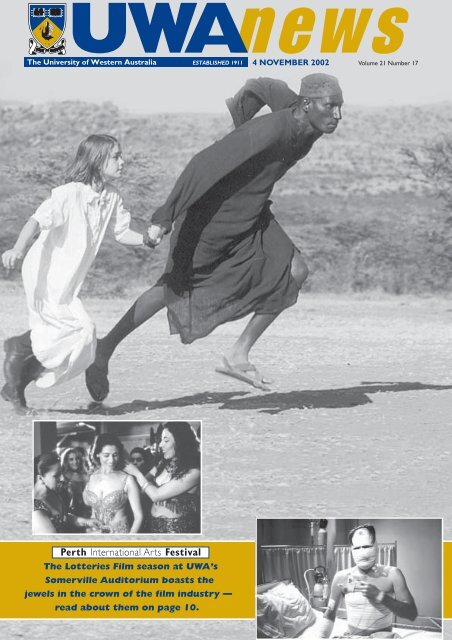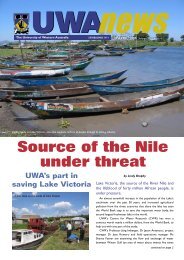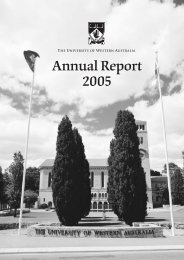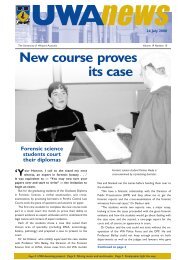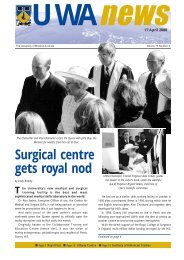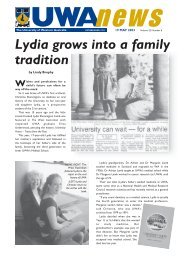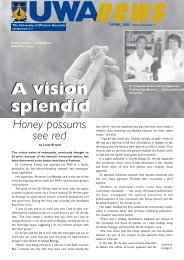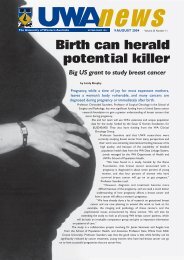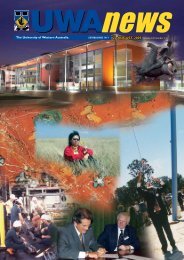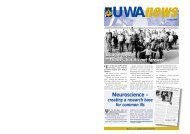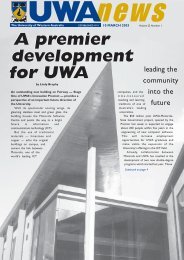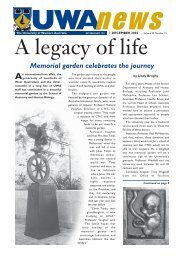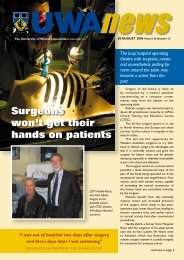WERB news 4 Nov - Publications Unit - The University of Western ...
WERB news 4 Nov - Publications Unit - The University of Western ...
WERB news 4 Nov - Publications Unit - The University of Western ...
Create successful ePaper yourself
Turn your PDF publications into a flip-book with our unique Google optimized e-Paper software.
<strong>news</strong> UWA4 NOVEMBER<strong>The</strong> <strong>University</strong> <strong>of</strong> <strong>Western</strong> Australia ESTABLISHED 19112002 Volume 21 Number 17Perth International Arts Festival<strong>The</strong> Lotteries Film season at UWA’sSomerville Auditorium boasts thejewels in the crown <strong>of</strong> the film industry —read about them on page 10.
2 UWA<strong>news</strong>VCariousthoughts …One size does not fit allIt took a mighty national push in policy andimplementation across the Commonwealth tocreate the current Australian system <strong>of</strong> highereducation at the end <strong>of</strong> the 1980s.A reforming Federal Minister, in the form <strong>of</strong> UWA graduate,John Dawkins, determinedly pressed his vision <strong>of</strong> a greatlyexpanded university sector — involving the doubling <strong>of</strong>universities both through the transformation <strong>of</strong> Colleges <strong>of</strong>Advanced Education and the amalgamation <strong>of</strong> colleges anduniversities — and a great advance in access, not leastdependent on the new HECS provisions. A national researchcouncil was also brought into being. A major CommonwealthMinistry grew up to oversee, fund and administer this newnational phenomenon <strong>of</strong> the unified national system.A distinctly centralised system had been set in motion, inwhich the best outcomes lay in access and research focus, andthe least attractive aspects in a ‘one size fits all’ funding andpolicy model.That centralising paradigm, and tendency <strong>of</strong> levelling down toa national norm, is in urgent need <strong>of</strong> transforming reform,towards the creation <strong>of</strong> a system <strong>of</strong> genuine diversity andrecognised missions among Australian universities.In all the debate about funding and budgets, that policy thrusthas been far too little discussed. And yet the move towards amore pluralistic system, <strong>of</strong> excellence through diversity <strong>of</strong>choice and institutional initiatives, could be the transforminghallmark <strong>of</strong> the Nelson review initiative.As with micro-reform in the economy at large, theuniversities are ready for an environment <strong>of</strong> much greaterflexibility and freedom, which draws from the capacities <strong>of</strong>universities themselves, recognising the importance <strong>of</strong> a nationalframework <strong>of</strong> operation and accountability for public fundingfrom the Commonwealth.<strong>The</strong>re are fears that such a flexible framework <strong>of</strong> choice, asadvanced strongly by the AVCC, might lead to a hierarchy <strong>of</strong>universities and not a pluralism <strong>of</strong> quality and equal institutions.That could happen in an inappropriate policy framework andfunding mix.UWA<strong>news</strong>EDITOR/WRITERLindy BrophyTel.: 9380 2436 Fax: 9380 1192 Email: lindy.brophy@uwa.edu.auEDITOR-IN-CHIEFColin Campbell-FraserTel: 9380 2889 Fax: 9380 1020 Email: ccampbell@admin.uwa.edu.auDesigned and typeset by <strong>Publications</strong> <strong>Unit</strong>, UWAPrinted by UniPrint, UWAUWA<strong>news</strong> online: www.publishing.uwa.edu.au/uwa<strong>news</strong>/But it should not happen if some fundamental policy and fundingchanges were put in place, namely:• raising the base-funding <strong>of</strong> all universities with significantlymore core funding and more appropriate indexation <strong>of</strong> allaspects <strong>of</strong> that Commonwealth resourcing;• new fully-funded places to meet demand, combined with adynamic model for redistributing places between regions andinstitutions based on demand and mission;• additional research and infrastructure resourcing distributedon the basis <strong>of</strong> highest quality performance;• significant contestable funding aimed to support regionalprovision <strong>of</strong> higher education and major equity initiatives;• flexibility for universities to set a HECS level above (orbelow) a standard rate, coupled with an equivalent volume <strong>of</strong>resources for contestable allocation for those institutionsnot wishing to vary HECS charges; and• support for universities to build their entrepreneurialincomes – in overseas students, industry resources andphilanthropy.Such a major set <strong>of</strong> initiatives would, over a period <strong>of</strong> time,significantly lead to the creation <strong>of</strong> universities that representvery different missions, have very different cost drivers, and thatwish to pursue their own sense <strong>of</strong> development in the future.While all Australian universities could now benefit fromreform <strong>of</strong> policy and reform <strong>of</strong> funding allocations whichrecognises the missions special to each university, UWA is aclassic case <strong>of</strong> a fine university constrained in its growth,performance and potential by the ‘one size fits all’ policyparadigm.<strong>The</strong>re is also a new collaborative role for the States to playin building higher education capacity in their special regions —without lessening Commonwealth responsibilities in corefunding. And there is a great opportunity for theCommonwealth to replace the old policy paradigms andexcessively bureaucratic reporting demands, with a moreresponsive and modern approach.A new century needs a new spirit to shape universityeducation for the changing society in which we live. It isdiversity rather than conformity which will deliver theexcellence which our staff and students deserve.Pr<strong>of</strong>essor Deryck SchreuderVice-Chancellor and Presidentvc@acs.uwa.edu.auTHE UNIVERSITY OF WESTERN AUSTRALIA • 4 NOVEMBER 2002
UWA<strong>news</strong> 3New school,new strategiesextend the visionPr<strong>of</strong>essor D’Arcy Holman sits in an <strong>of</strong>fice in theState Government’s Health Department andcompares the beginnings <strong>of</strong> UWA’sDepartment <strong>of</strong> Public Health in 1991 with the launch <strong>of</strong>our new School <strong>of</strong> Population Health last month.<strong>The</strong> biggest difference is the reputation the School hasdeveloped – reflected in the fact that the Head <strong>of</strong> School is alsonow a key player in the State health system. He is leading ahighly respected and widely recognised school <strong>of</strong> teachers andresearchers who are well on the way to achieving the vision towhich they aspired back then.That vision remains at the top <strong>of</strong> the new school’s strategicinitiatives and it is: We will influence policy and practice to improvethe public health through leadership in education and in the discoveryand communication <strong>of</strong> knowledge.From modest beginnings, the enthusiastic healthpr<strong>of</strong>essionals who made up the Department <strong>of</strong> Public Healthtook on research projects, ran stimulating courses and came upwith innovative programs for public health. <strong>The</strong>y becamerecognised, they were asked for advice and the departmentgrew rapidly during the 1990s, constantly breaking into newareas and proving themselves.“Our position in the health system has consolidated over thepast few years,” Pr<strong>of</strong>essor Holman said. “But now that we arebetter known and more confident, we must be careful not tolose our excitement, not to become complacent. We must bebreaking new ground all the time.”<strong>The</strong> launch <strong>of</strong> the new School, hosted by Acting Vice-Chancellor, Pr<strong>of</strong>essor Alan Robson, with the Health MinisterBob Kucera, as the special guest, engendered excitement.Pr<strong>of</strong>essor Fiona Stanley spoke about the importance <strong>of</strong>population health as an academic discipline, Associate Pr<strong>of</strong>essorMatthew Knuiman recalled the development <strong>of</strong> the departmentwhich became a School, and Pr<strong>of</strong>essor Holman talked about theSchool’s strategic future.Pr<strong>of</strong>essor Holman’s immediate future is a metaphor for therest <strong>of</strong> the School. It is partly dominated by the reviewcommittees, councils and forums he chairs, as a leader in publichealth policy making. He is currently chairing reviews <strong>of</strong> theMental Health Act and the Mentally Impaired Defenders Act,which involve more than 100 people in the committeestructure.He is President <strong>of</strong> HealthWatch, a standards and surveillancecouncil, and chair <strong>of</strong> the Wagerup Medical Practitioners’ Forum,looking at the health problems associated with the WagerupAlumina Refinery.He is also chair <strong>of</strong> the Data Linkage Committee and has justdrafted a memorandum <strong>of</strong> understanding between the State andFederal governments which will open the way for national healthrecords to be brought into the State’s record linkage project.<strong>The</strong> project, which links the medical records <strong>of</strong> the people <strong>of</strong><strong>Western</strong> Australia is unique in Australia and one <strong>of</strong> only sixsuch systems in the world. It has already provided valuableinformation for the Duty to Care study <strong>of</strong> the physical healthproblems <strong>of</strong> people who use Mental Health services in WA, andthe Quality and Safety <strong>of</strong> Surgical Care project, which evaluatedoutcomes <strong>of</strong> common and important surgical procedures inWA.“<strong>The</strong> new School will build on the successes achievedthrough the collective contribution <strong>of</strong> all our staff, past andpresent, and aims to increase our contribution to the nationaland international research and teaching effort throughpartnership with others,” Pr<strong>of</strong>essor Holman said.“Symbolic <strong>of</strong> this approach is our joint success with theInstitute for Child Health Research in winning the first awardedNational Health and Medical Research Council’s CapacityBuilding Grant.“This will guide the spirit <strong>of</strong> our endeavours over the nextfive years.”Pr<strong>of</strong>essor Alan Robson (left) and Pr<strong>of</strong>essor D’Arcy Holman talk toHealth Minister Bob Kucera (centre) about the new schoolTHE UNIVERSITY OF WESTERN AUSTRALIA • 4 NOVEMBER 2002
4 UWA<strong>news</strong>Better connectionswith the bush<strong>The</strong> Prime Minister awards the funding to (from left) Rowan Maclean, Des Hutchinson,Alex Reid and Martin RowlesUWA has spearheaded a campaignwhich will result in up to 19regional centres getting vastlyimproved telecommunicationsservices.Alex Reid, the <strong>University</strong>’s IT policyexecutive <strong>of</strong>ficer and Pr<strong>of</strong>essorialFellow in the School <strong>of</strong> ComputerScience and S<strong>of</strong>tware Engineering, wasthe driving force behind the bid forNational Communications Fund money,to improve technology links for healthand education institutions around thestate.He represented all the publicuniversities in WA and the group alsoincluded the government departments<strong>of</strong> industry and technology, health,education and training.“We put in a bid for $20m andeventually we were allocated $8m,” MrReid said. “<strong>The</strong> initial bid was toupgrade services at 58 schools,hospitals, university centres and otherhealth and education sites within 19towns from Esperance to Kununurra.We are now negotiating with Optus andTelstra to see how much we can dowith $8m. It could mean that we couldimprove services to all those sites butthey would have a slower capability thanwe would have preferred.”Mr Reid said the funding would meanpotentially better telecommunicationlinks between UWA’s Crawley campusand its Albany, Geraldton and Kalgoorliecentres.“Curtin and Edith Cowan universitieswill actually benefit more than us as theyhave more regional centres. But it isimportant for UWA to be out there,playing its part in the community, even ifwe don’t benefit hugely,” he said.“It certainly helped our bid to havethe whole <strong>of</strong> the education and healthsystems applying together. It was one <strong>of</strong>the strongest bids in the country.”<strong>The</strong> Deputy Vice-Chancellor,Pr<strong>of</strong>essor Alan Robson, said Mr Reid’sinvolvement in the bid was critical and itwas his enthusiasm that got theconsortium going.“When I became aware that thisfederal government funding wasavailable, I contacted the StateDepartment <strong>of</strong> Industry and Technologyto see if they were making a bid andthey asked me to join them in a coordinatedbid. I encouraged the otheruniversities to join with us,” Mr Reidsaid.It will take up to three years for thefunding to be deployed andtelecommunications with the bushsignificantly improved.How is yourengine running?<strong>The</strong>re were a few high performance Ferraris, someclapped out old Holdens and lots <strong>of</strong> middle <strong>of</strong> theroad family sedans.<strong>The</strong> UWA Medical Centre’s Pit Stop last month attracted allsorts <strong>of</strong> ‘vehicles’ as men on campus took the opportunity <strong>of</strong> afree comprehensive health check.<strong>The</strong> health promotion program targeted men and invitedthem to take themselves ‘over the pits’, encouraging them tolook after themselves as they look after their cars.<strong>The</strong> program was made up <strong>of</strong> eight pit stops, includingchassis check (weight issues), oil pressure (blood pressure),exhaust (smoking), fuel additives (alcohol), spark plugs(testicular cancer), duco (skin cancer) and torsion (flexibility).More than 70 students and staff took the opportunity <strong>of</strong>‘passing the pits’ at the Guild Village. Tricia Wylde, whoorganised the health check, said she was delighted with theresponse. Everybody who attended was given individual adviceand left with their work order completed and new ‘regosticker’ proclaiming that the vehicle was licensed androadworthy.Human Movement student Jamie Brooksby (right)checks ‘the spark plugs’Suzanna Bosnjic (Student Services)and Tricia Wylde (rear) check outcommerce student Greg Weinsteinand James Anderson (OFM)Straun Burges (HumanMovement) helps medicalstudent Sam Lieblich test hisflexibilityTHE UNIVERSITY OF WESTERN AUSTRALIA • 4 NOVEMBER 2002
UWA<strong>news</strong> 5Telephone Inquiry Service’TIS wonderfulWe all know that if you want to find somethingout, you go to a library.But the <strong>University</strong> Library’s Telephone Inquiry Service (TIS)has carried this assistance beyond usual library boundaries.Since 1998, the service has been staffing an information line10 hours a day, five days a week, and dispensing such excellentand diverse information that one caller exclaimed:’“You have allthe information I need … can you give me the numbers forSaturday’s Lotto?!”Under the supervision <strong>of</strong> Sally Kenton, Client ServicesSupervisor, six Library Officers from the Business Library sharethe calls. <strong>The</strong>y staff the phone for an hour-and-a-half at a time,and deal with inquiries ranging from advice on book borrowingand library membership to the availability <strong>of</strong> teleconferencingfacilities at UWA.“If we don’t know the answer to a query, we find out asquickly as possible and get back to the caller, then record thatinformation in our TIS guide for future reference,” said SallyKenton.While the majority <strong>of</strong> queries are library related, the servicehas grown to include referral to information sources in the<strong>University</strong> at large.“We are not a switchboard but an information service whichcollaborates with Shelley Fong and her switchboard team,” Sallysaid.Helen Wallace, Business and Law Librarian and manager <strong>of</strong>the section, said the success <strong>of</strong> the service was due to thepeople on the TIS team who had a dynamic approach to theirwork and always followed everything through.One <strong>of</strong> the Library Officers who staffs the phone, DonMcSkimming, said callers appreciated getting a real person onthe phone instead <strong>of</strong> a recorded message.At night, the TIS is switched through to the staff in theHumanities and Social Sciences Library until library closing time<strong>of</strong> 10pm. On the weekends, it carries a diversion message withan option to speak to a staff member.<strong>The</strong> staff said they were busiest on public holidays whencallers knew they were one <strong>of</strong> the few information services inPerth which were open.Another TIS member, Angela Germanier, said the nonlibraryqueries she might deal with during her hour-and-a-halfshift could include a question about where a caller could buy abook; members <strong>of</strong> the public wanting to book venues; staffneeding to borrow audio-visual equipment; copyright queries;people looking for lost property; where to find a JP and how tomake a bequest.Sally Kenton said the staff occasionally dealt with stressedcallers (particularly parents <strong>of</strong> young students) and it wasimportant that TIS staff provide an empathetic ear.“It’s a low tech personalised service with the emphasis onproviding friendly, helpful and accurate service,” she said.“Shelley Fong, on the switchboard, says the service has beentrouble free and one for which they receive no complaints!”One <strong>of</strong> the many positive responses from callersencapsulated the service: “…it is so good to get help, adviceand service with no attitude … with no regard to whether ornot I was a student, academic or a member <strong>of</strong> the public…”As well as providing an excellent service and promoting thegood name <strong>of</strong> the <strong>University</strong>, TIS staffing reflects the Library’ssupport <strong>of</strong> UWA’s Workforce Diversity Strategy: two <strong>of</strong> the10 members <strong>of</strong> the team were employed through the DiversityJob Bank.Mirela Mercea (back), Don McSkimming and Sally Kenton (centre)observe Rosanne Althorpe deal with an inquiryTHE UNIVERSITY OF WESTERN AUSTRALIA • 4 NOVEMBER 2002
6 UWA<strong>news</strong>a fortress cityuncoveredDesert sand gives upa 2,000 year old city …Archaeologists <strong>of</strong> the 21st century tend to get more excited by thescrapings <strong>of</strong> a domestic fireplace than the statues from a temple.“Of course everything is precious and vital to building up a picture <strong>of</strong> a community,but these days, we are more interested in the environment and the ecology <strong>of</strong> aparticular place and time, rather than the public life <strong>of</strong> a community,” said eminentarchaeologist Pr<strong>of</strong>essor Graeme Clarke (pictured right), who visited UWA recently.Pr<strong>of</strong>essor Clarke, the Australian Archaeological Institute at Athens Visiting Lecturerfor 2002, presented some <strong>of</strong> his past 16 years’ work in Syria at a public lecture for theSchool <strong>of</strong> Humanities (Classics and Ancient History).Since 1986, he has been leading an excavation <strong>of</strong> the abandoned Hellenistic city <strong>of</strong>Jebel Khalid on the west bank <strong>of</strong> the Euphrates River in North Syria, about 60kilometres south <strong>of</strong> the Turkish border.He discovered the lost city while conducting a survey for a Melbourne team <strong>of</strong>archaeologists who were excavating a Bronze Age site further up river.“I came across some pottery pieces, which eventually led me to the remnants <strong>of</strong> acity wall, and I realised what I had found,” Pr<strong>of</strong>essor Clarke said.Excavation <strong>of</strong> the site began two years later and Pr<strong>of</strong>essor Clarke, who was then apr<strong>of</strong>essor <strong>of</strong> classical studies and Director <strong>of</strong> the Humanities Research Centre at theAustralian National <strong>University</strong>, got together a team which goes to the site every yearfor two months.“We have to employ a guard for the other 10 months <strong>of</strong> the year. But it’s just notpractical to work at the dig for longer than that period each year,” he said.“For a start, the conditions are very hard and it’s difficult to get a team <strong>of</strong> expertstogether for any longer than a couple <strong>of</strong> months.“Each year the team we take with us might include an illustrator, a photographer, aconservator, an architect, a surveyor, metal, glass and coin experts and a botanist. Wetake between 15 and 18 people and employ up to 90 locals at the site. It looks likeRaiders <strong>of</strong> the Lost Ark when we’re at full strength!”Jebel Khalid was a Greek fortress 30 hectares in area built on a limestone plateau atthe beginning <strong>of</strong> the third century BC.“It was newly conquered territory for Alexander the Great and the city was a“<strong>The</strong> charcoal remainsfrom the fireplaces tell uswhat wood grew in thearea so we know howdamp it was. Soil samplescan also tell us what sort<strong>of</strong> plants grew and we canbuild up an ecologicalpicture…”THE UNIVERSITY OF WESTERN AUSTRALIA • 4 NOVEMBER 2002
UWA<strong>news</strong> 7military colony built to guard a rivercrossing,” Pr<strong>of</strong>essor Clarke explained.“It was abandoned in the first half <strong>of</strong> thefirst century BC when the Greekdynasty collapsed and the Romanschanged their protection strategies.“Jebel Khalid was not the sort <strong>of</strong> placeyou would stay in if it no longer had a use.Everybody lived inside the fortress wherethere was no natural water and thepeople all had to leave the fortress to goout and work in their fields, then comeback in again at night.“Being an abandoned city means thatwhat we are finding is their rubbish,what they didn’t want and what theyfound too heavy or awkward to takewith them. It is all covered in 2,000years <strong>of</strong> dust and sand.”But, slowly, Pr<strong>of</strong>essor Clarke and histeam are building up a picture <strong>of</strong> theenvironment on this plateau on thebanks <strong>of</strong> the Euphrates, more than2,000 years ago.“We have found olive pips and grapeseeds preserved in the fireplaces, so weknow they grew them. <strong>The</strong> charcoalremains from the fireplaces tell us whatwood grew in the area so we knowhow damp it was. Soil samples can alsotell us what sort <strong>of</strong> plants grew and wecan build up an ecological picture.”It has taken around 13 years toexcavate about 10 domestic houses ona large block. <strong>The</strong>y have learned aboutthe women’s activities at home whilethe men worked the fields, findingevidence <strong>of</strong> spinning, weaving andcooking.“We are interested in finding outhow people lived, their culinary habits,their diets, so we go first for domestichomes rather than public buildings.“We have found a lot <strong>of</strong> stew potswhich means they didn’t eat theiranimals until the end <strong>of</strong> the stock’suseful life. <strong>The</strong>y would have used theirsheep, goats and horses for carryingloads and providing milk for cheese andyoghurt, and for wool. <strong>The</strong> only younganimals they slaughtered were pigs andthe native gazelle.”Pr<strong>of</strong>essor Clarke said his teamworked ‘fiendishly hard’ every Marchand April, rising at 4.30am, working atthe dig until midday, then spending theafternoon analysing, conserving andcataloguing their finds until the lightfaded.“Essentially, we work a double shiftevery day. And living in a Bedouin villagein the heat and dust where we mustcommunicate in Arabic with the localsand share two showers between 18people makes it hard going.”He said they had found coins at thedig from the fourth century AD.“<strong>The</strong>se were dropped by what we callstone robbers. A lot <strong>of</strong> the stone hasbeen taken from the city. <strong>The</strong>re isevidence that tractors came in duringthe 20th century to take stone away.“<strong>The</strong> French encouraged theBedouins to become sedentary. Somany <strong>of</strong> them robbed the city <strong>of</strong> itsbuilding blocks, to provide theirpermanent homes. It’s still happening.When we were there this year, somelocals came to take away some stoneblocks because somebody in theirvillage had died and this is how theybury them, under stone blocks.”Everything the team unearths at JebelKhalid belongs to the Syriangovernment. <strong>The</strong> major pieces go tothe museum at Aleppo, the nearest cityand the second biggest city in Syria, afterDamascus.“But they are only interested inwhole pieces. As it’s an abandoned site,there are plenty <strong>of</strong> broken plates, whichare fine for the information they cangive us, but not for display in a museum.“<strong>The</strong>re are many more years <strong>of</strong> workin the dig but eventually, we willprobably get permission to take some <strong>of</strong>the unwanted pieces out <strong>of</strong> the country.In the meantime, they stay in storage,”he said.Pr<strong>of</strong>essor Clarke explained that histeam would not excavate the entire site.“<strong>The</strong>se days we leave something forthe archaeologists who come after usbecause they’ll be looking for differentthings,” he said. “Thirty years ago, wewouldn’t have been interested in theecology and environment <strong>of</strong> a site; wewould have been looking at differentaspects. And it will change again.“So we only ever ‘sample’ a site now.We have only excavated one <strong>of</strong> the 30columns in the fortress wall. We don’tneed to unearth all 30 because they willall tell us the same thing.”As the visiting pr<strong>of</strong>essor for theAustralian Archaeological Institute atAthens (AAIA), Pr<strong>of</strong>essor Clarke istouring Australia and visiting all theuniversities which support the AAIA.“I am very pleased to report that theclassical studies departments around thecountry are hanging on. <strong>The</strong>y seem tohave stabilised after being under threatfor a while. But who knows what willhappen in the future?”Graham Clarke on sitein SyriaTHE UNIVERSITY OF WESTERN AUSTRALIA • 4 NOVEMBERS 2002
8 UWA<strong>news</strong>Anawardwinningbalancingactreducing energyincreasing recycling<strong>The</strong> <strong>University</strong> has topped the sector in reducingenergy consumption.A survey <strong>of</strong> 24 higher education institutions world-wide has putUWA at the forefront <strong>of</strong> energy management. <strong>The</strong> study byEnergetics (a corporate arm <strong>of</strong> <strong>Western</strong> Power) indicated thatUWA had progressed from two stars (representing 33 per centachievement in reducing energy consumption) in May 2000, tothree stars (representing 53 per cent) in August this year. Energeticshas assessed 767 sites world wide, 51 in the education sector.Of these 51 sites, 24 are higher education institutions.UWA’s rating <strong>of</strong> 2.4 is the highest recorded in the sector. <strong>The</strong>average in the sector is 1.4.UWA’s environmental manager, Gordon Walsh, said it wasimportant that the very good work carried out by OFM staff,particularly Tony Humphries, John King, Stuart Townsend,Bruce Thompson and Russell Candy, with regard to energymanagement and environmental sustainability, was recognised.If it was anybody else, you might be worried. But asJeremy Smith is an anatomy and human biologystudent, on the brink <strong>of</strong> completing his PhD and anational award-winner to boot, it’s likely that he knowswhat’s best for his own anatomy.For the past few years, Jeremy has been sitting on a biginflated exercise ball instead <strong>of</strong> a chair, to work at his computer.“I’m a sprinter and I train hard. I found that sitting in anorthodox chair all day affected my back, which in turn affectedmy hamstrings. A physiotherapist suggested I try sitting on aball instead <strong>of</strong> a chair – and I’ve never looked back!” he said.His career will probably never look back either, as Jeremyrecently won the 2002 Junior Scientist Award from the Societyfor Reproductive Biology (SRB).He received the award for his paper, co-authored with hisPhD supervisor Associate Pr<strong>of</strong>essor Brendan Waddell, on leptindynamics in pregnant rats.<strong>The</strong> hormone leptin is produced primarily by fat cells and isbest known for its role in regulating food intake andmetabolism. But leptin also plays several roles in reproduction,most notably as a signal for puberty onset and the promotion <strong>of</strong>fetal growth. Jeremy’s work has focussed on the biology <strong>of</strong>leptin during fetal and postnatal development.“<strong>The</strong> work we presented at the SRB’s Annual ScientificMeeting in Adelaide was on how the transport <strong>of</strong> themother’s leptin to the fetus changes during pregnancy,and how this transport is disturbed in a model <strong>of</strong> fetalgrowth retardation,” he said.Pr<strong>of</strong>essor Waddell pointed out that Jeremy wasthe fourth winner <strong>of</strong> the Junior Scientist Award fromthe SRB from the School <strong>of</strong> Anatomy and HumanBiology since 1985.“This is an incredible success rate for a single Schoolgiven that the SRB is a national society (including NewZealand) and the big funding for reproductive biology researchover this period has been in Melbourne and Adelaide,”Pr<strong>of</strong>essor Waddell said.“Where sound energymanagement systems can be putinto place, the real success tothe energy reduction program lies with every individual oncampus, as it is the lighting and computer use that is by far thegreatest factor effecting the energy consumption on campus,”Mr Walsh said.“Even though we are doing well, we must not becomplacent. We can still do better and that largely depends onindividuals turning <strong>of</strong>f their computers and lights when they areleaving them for an extended period,” he said.<strong>The</strong> <strong>University</strong>’s recycling efforts are also improving. MrWalsh provided figures comparing equivalent energy saved byrecycling in July ( at the start <strong>of</strong> the new program), comparedwith August and September.<strong>The</strong>re has been a steady increase in effective recycling. InSeptember we recycled 40.43 tonnes <strong>of</strong> waste (compared with14.5 tonnes in July), saving the equivalent <strong>of</strong> 525 trees (302 inJuly), 165,601 kWh <strong>of</strong> power (95,413) and 161 square metres <strong>of</strong>landfill (93).THE UNIVERSITY OF WESTERN AUSTRALIA • 4 NOVEMBER 2002
UWA<strong>news</strong> 9SocratesandGandalf –modelsformentorsMentor was the faithful friend<strong>of</strong> Odysseus in Greek mythology,who then became the wiseadviser to his son, Telemachus.But, as Director <strong>of</strong> Students Services,Jon Stubbs, pointed out to a roomful <strong>of</strong>student mentors, Odysseus andTelemachus didn’t turn out too well andhe preferred the example <strong>of</strong> Plato andhis mentor Socrates.Mr Stubbs was thanking the studentsfor their participation in UWA’s(student) Mentor Scheme. This year, 396students gave up their time to be trained,then matched with first year students,whom they helped over the first fewdifficult weeks <strong>of</strong> first semester. Somestudents remained in contact with theirmentees all year. More than 1,100 firstyears took advantage <strong>of</strong> the scheme.Fiona Turnbull was Daliboy Acimic’s mentorthis year. <strong>The</strong>y are both commercestudents.Student Services administrates thescheme and they put on an appreciationceremony last month, at which thementors were also thanked by ActingVice-Chancellor, Pr<strong>of</strong>essor AlanRobson, and Guild President, RyanBatchelor.Pr<strong>of</strong>essor Robson told the studentshow the scheme had begun in (his)faculty <strong>of</strong> Agriculture (now Natural andAgricultural Sciences) and that he hadalso been a mentor, to some members<strong>of</strong> staff.Ryan Batchelor congratulated thementors for putting something back intothe <strong>University</strong> by helping out the firstyear students.Many <strong>of</strong> the mentors said they wouldtake part in the scheme again next year(for some it would be their thirdconsecutive year <strong>of</strong> mentoring) and thattheir mentees were also eager to trainand help first years in 2003.Jon Stubbs left them with quite adifferent perception <strong>of</strong> first yearstudents when he said that his favouritementor <strong>of</strong> all was Gandalf, from Lord <strong>of</strong>the Rings, who looked after thecreatures <strong>of</strong> Middle Earth and drew outthe courage <strong>of</strong> the Hobbits … or firstyears!Students rallyfor kidsTwo thousand, three hundreddays <strong>of</strong> care for kids do notcome cheaply.Between three full day picnicsand three week-long camps, UniCamp for Kids (UCFK) providesthis care for many <strong>of</strong> Perth’s lessprivileged five to 12 year oldchildren every year. That isequivalent to caring for a singlechild for more than six years.Throw in trips to AdventureWorld, water slides, Perth Zoo anda host <strong>of</strong> other must-sees foryoungsters and the annual bill tokeep the charity afloat hovers nearthe $70,000 mark.<strong>The</strong> students’ latest fundraiserwas the annual UCFK Car Rally,which was, as usual, well attendedand a social as well as a financialsuccess. But this time <strong>of</strong> the yearheralds the critical fund-raisingperiod, with the c<strong>of</strong>fers beingdepleted by the recent picnic andthree weeks <strong>of</strong> camps coming up inJanuary.UCFK welcomes public andcorporate support. Anyone wishingto make a donation to help thisyear’s camps can call 9380 2648.Setting out on the annual UCFK carrally (from left): Scott Fitzgerald fromECU, Human Movement graduateEmma Attwood, Pip the pirate’s ‘parrot’and UCFK president and HealthScience student Luke van Zeller.THE UNIVERSITY OF WESTERN AUSTRALIA • 4 NOVEMBERS 2002
10 UWA<strong>news</strong>Food, flowers,Finland &Francis FordCoppolaAcomedy to open the season, a sumptuousfood film for Christmas week, and a movie setin the freezing Arctic wilderness for the firstblistering week <strong>of</strong> February – the Somerville filmseason is perfectly planned.<strong>The</strong> Lotteries Film Season is always the first part <strong>of</strong> thePerth International Arts Festival to get up and running – andthe last to finish, with the final film screening at the SomervilleAuditorium from March 31 to April 6.<strong>The</strong> final <strong>of</strong>fering is a documentary featuring 11 <strong>of</strong> theworld’s leading filmmakers and their 11-minute viewpoints <strong>of</strong>September 11.<strong>The</strong> first film, Greenfingers (December 2 to 8) gives newmeaning to ‘flower power’ as the Hampton Court PalaceFlower Show is hotly contested. Helen Mirren is an eccentricand flamboyant gardening guru in the mould <strong>of</strong> Joyce Grenfell.For completely different female characters, wait for thesecond film, <strong>The</strong> Business <strong>of</strong> Strangers (December 9 to 15),which has been described as maliciously funny and with morebite and wit than the mainstream can provide. Twobusinesswomen are stranded in an airport and theirrelationship becomes a psychological thriller.Dinner Rush (December 23 to 29) is set in a trendyManhattan eatery with the themes <strong>of</strong> food, fun and family.This year’s Cannes Film Festival winner <strong>of</strong> the Grand Prixand best actor awards went to a Finnish film, <strong>The</strong> Man Without APast (January 6 to 12). It’s the quirky and uplifting tale <strong>of</strong> a manwhose life and memory are taken away from him, a story aboutpeople living it tough on the fringes <strong>of</strong> society who still knowhow to be gentle.<strong>The</strong> first feature film made in the Inuktitut language,Atanarjuat — the Fast Runner (January 27 to February 2), is set inthe eastern Arctic wilderness, sure to cool you down on a hotsummer night.A new view <strong>of</strong> piano teachers, a new life for a Tunisianwidow and a new print <strong>of</strong> Francis Ford Coppola’s Palme d’Orwinning film <strong>of</strong> 1974, <strong>The</strong> Conversation (March 5 to 8) are allincluded in the season. An Italian political satire, an Iranian‘work <strong>of</strong> art from a visual poet’ and the touching story <strong>of</strong> twoelderly French sisters, one with an intellectual disability, provideplenty <strong>of</strong> variety.Tickets for the Somerville season are available from BOCSor at the door. Standard tickets are $13, Friends <strong>of</strong> the Festival$11, pensioners, students, seniors, backpackers andunemployed, $8. Gates open for picnickers from 6pm and thefilms begin at 8pm.ExtendingservicestoMotorolaBy the time you read this, those staff and students who walk past thegeography, geology and physics buildings each day, will probably be ableto do so as easily as they used to.For several weeks, the path outside those buildings has been dug up as contractorsand some staff from the Office <strong>of</strong> Facilities Management have upgraded undergroundservices.Project <strong>of</strong>ficer Bob Davies explained that the main purpose <strong>of</strong> the work was toextend the chilled water services to the new Motorola building on Fairway.“While we were at it, we decided to update the irrigation mains. <strong>The</strong> old irrigationmains now carry optical fibres to the Motorola building,” he said.<strong>The</strong> work has extended to the back <strong>of</strong> this precinct, alongside the computer sciencebuilding and to the south <strong>of</strong> the art gallery.Gas mains have also been extended. Mr Davies explained that after the old stormwater system was replaced in front <strong>of</strong> geography/geology, the drains needed to be backfilledand the soil around and above them compacted before the gas mains could be laid.“It might have looked to the uninitiated as though we had filled in everything, thensuddenly remembered the gas mains and dug it all up again, but this is how it had to bedone,” he said.<strong>The</strong>re are seven sites on campus where services are being progressively upgraded.THE UNIVERSITY OF WESTERN AUSTRALIA • 4 NOVEMBER 2002
UWA<strong>news</strong> 11A tribute tothe first DVC<strong>The</strong> man who created theposition <strong>of</strong> Deputy Vice-Chancellor at UWA died in theUK last month.Current Deputy Vice-Chancellor,Pr<strong>of</strong>essor Alan Robson, paid tribute toPr<strong>of</strong>essor Charles John Birkett Clews,who became the first DV-C in 1962.Pr<strong>of</strong>essor Robson said that prior to1962, the <strong>University</strong>’s executivestructure had not included the position<strong>of</strong> Deputy Vice-Chancellor.“From 1962 until late 1972,Pr<strong>of</strong>essor Clews helped steer UWAthrough a vital decade <strong>of</strong> development,as deputy to Sir Stanley Prescott, andlater, Pr<strong>of</strong>essor Robert Wheelan.”Born in London in 1912, Pr<strong>of</strong>essorClews studied physics extensively inboth the UK and Europe, and from1940 supported the British war effort asa scientific adviser with direct links tothe War Cabinet Office.In 1952, he accepted the position <strong>of</strong>Pr<strong>of</strong>essor <strong>of</strong> Physics and Head <strong>of</strong> theDepartment <strong>of</strong> Physics at UWA. Twoyears later he was appointed Dean <strong>of</strong>the Faculty <strong>of</strong> Science, and was also amember <strong>of</strong> the <strong>University</strong> governingbody, the Senate, and Chair <strong>of</strong> UWA’sPr<strong>of</strong>essorial Board from 1956-57.In the early 1960s he was aconsultant to the Australian Institute <strong>of</strong>Nuclear Science and Engineering, andfor many years a member <strong>of</strong> the Statecommittee <strong>of</strong> the CSIRO.What adifferencea daymakesAboriginal school children inthe Albany area have startedthinking about aiming for auniversity education.Two groups <strong>of</strong> Noongar children, adozen from local primary schools andanother similar group from regional highschools, each spent a day at UWA’sAlbany Centre recently, under theVocational and Educational Guidance forAboriginals Scheme (VEGAS).UWA Albany’s development <strong>of</strong>ficer,Randall Jasper, talked to the childrenabout UWA, the Albany connection andtertiary study in general.<strong>The</strong> students then spent time withone <strong>of</strong> the Albany tutors, GrahamMcKeich, who teaches geography. Heand Mr Jasper co-ordinated hands-onactivities, mapping and usingstereoscopes.“<strong>The</strong>y loved finding Noongar placenames on maps,” Mr Jasper said.With the help <strong>of</strong> Marilyn Strotherfrom the School <strong>of</strong> Indigenous Studies,the students then did some field workwith biologist Kirsty Alexander from theCLOCKWISE FROM TOP: Kirsty Alexanderexplains about the marine life found in theriver; using stereoscopes for mapping;concentrating …Waters and Rivers Commission. <strong>The</strong>ytook mud samples from Oyster Harbourand analysed them. <strong>The</strong> children wereamazed at the different marine animalsthey found living in the mud.<strong>The</strong>y also inspected fish traps andtalked with Sam Williams, a localNoongar elder, and his daughter SamMerritt about them.<strong>The</strong> older children did some work inthe areas <strong>of</strong> archaeology and philosophy.“But it was more <strong>of</strong> an educationalday than work experience. We wantedthe students to have fun learningsomething new and to understand thatthis is what university can be like,” MrJasper said.“At the end <strong>of</strong> the day, we gave themall lollies but, before they could havethem, they had to promise that they’dcome back here and enrol at <strong>University</strong>when they left school!” he said.C A M P U SsecretsThis enticing little path disappearsinto the shrubbery on the south side<strong>of</strong> the administration building.Follow it and it takes you down tosome equally enticing looking stone stepsto a basement door. It actually leads to atea room and the staff from nearbyFinancial Services call it the dungeon.It’s been there for as long as anybodycan remember but only recently some <strong>of</strong>the bushes around it were cleared awayand the secret path was revealed to others.If you have a secret spot on campus,a favourite feature or a little-knownfact to share, please send it to us:lindy.brophy@uwa.edu.auor phone extension 2436, fax 1192.THE UNIVERSITY OF WESTERN AUSTRALIA • 4 NOVEMBERS 2002
12 UWA<strong>news</strong>last wordsize <strong>of</strong> Perth, it seems competition is to be a given in musiceducation in WA. This competition has resulted inconsequences both good and bad. High quality, comprehensivemusic education at tertiary level relies on critical mass; for largegroup activities such as orchestras and choirs, for bringingstudents together to learn from, inspire and compete with eachother, for maximizing resources and for achieving economies <strong>of</strong>scale. <strong>The</strong>re is little doubt that a higher standard <strong>of</strong> educationcould be achieved through a single tertiary music school in WAin place <strong>of</strong> the current competitive model.By Mark CoughlanHead, School <strong>of</strong> MusicIt is nearly 50 years since music was formallyestablished as a discipline at UWA. This period hasbeen characterised by growth, entrepreneurship,building foundations in music scholarship andperformance and strong community outreach. It hasalso been marked by periods <strong>of</strong> intense competitionboth within and external to the <strong>University</strong>.<strong>The</strong> initial 1907 proposal to establish a university in <strong>Western</strong>Australia included music as one <strong>of</strong> the disciplines and thecampus design competition required the inclusion <strong>of</strong> aconservatorium building. However, some decades later, the planto establish a lectureship in music within the Faculty <strong>of</strong> Arts wasopposed by the faculty, which had competing priorities tosupport other developing disciplines. So competition was anissue for music from the outset. Finally, in the face <strong>of</strong> ongoingopposition from the Arts Faculty, it was agreed to appoint aReader in Music in the Faculty <strong>of</strong> Education.<strong>The</strong> first classes were in music history and music educationbut the original vision <strong>of</strong> establishing a conservatorium withinthe <strong>University</strong> remained.<strong>The</strong> proposal was never realised at UWA and, despite thefact that degree courses in performance were developed, theinability to <strong>of</strong>fer a wider range <strong>of</strong> performance studies (such ascertificates and diplomas) ultimately led to the establishment <strong>of</strong>the WA Conservatorium <strong>of</strong> Music, which, as part <strong>of</strong> the WAAcademy <strong>of</strong> Performing Arts at Edith Cowan <strong>University</strong>, hasbeen competing with UWA in the provision <strong>of</strong> music degreesfor the past 15 years or so.Despite years <strong>of</strong> attempting to resolve the competitivetensions resulting from two tertiary music schools in a city theLABELHowever, on the positive side, competition has meant thatthe School <strong>of</strong> Music has had to work hard to remaincompetitive, ensuring a high level <strong>of</strong> student satisfaction,constantly reviewing its <strong>of</strong>ferings to ensure they are up to date,pr<strong>of</strong>essionally relevant and appealing to potential students. <strong>The</strong>School has monitored developments nationally andinternationally and new initiatives have been embraced,including historical performance scholarship linked withperformance on original instruments and more recently worldmusic, jazz improvisation and music technology. An increase inthe number <strong>of</strong> public concerts and their pr<strong>of</strong>essionalism andhigh pr<strong>of</strong>ile has benefited not only music students, but the<strong>University</strong> and wider community as well.After seeing the 2001 documentary film on the MusicDepartment <strong>of</strong> Sydney <strong>University</strong>, Facing the Music, I am not sosure the absence <strong>of</strong> competitive drive is always a good thing.Here was a music department that seemed trapped in a timewarp, one that had not been required to compete with theother music schools in Sydney (and there are at least fourothers) or seemingly within its own <strong>University</strong> for resources,student places or strategic support. <strong>The</strong> SydneyConservatorium, also part <strong>of</strong> the <strong>University</strong> <strong>of</strong> Sydney, had justreceived a new $150 million building but the Department <strong>of</strong>Music could not afford a few thousand dollars to pay someoneto take the choir.Facing the Music is an extreme example <strong>of</strong> the tensions andproblems many disciplines are experiencing in Australia. <strong>The</strong>simple approach to funding shortfalls is to cut <strong>of</strong>ferings, increaseteaching loads and hope for better times. This strategy did notwork for the Sydney department where it created a downwardsspiral which ultimately threatens its ongoing viability. In acompetitive climate, the cutting <strong>of</strong> certain aspects <strong>of</strong> a courseto save money might result in giving away competitiveadvantage to another institution. This could then lead to adecline in enrolments and snowballing financial problems.So as we celebrate the vibrant UWA music culture builtduring the past 50 years, the next 50 begins with the challenge<strong>of</strong> how we continue to pay for it. I read recently <strong>of</strong> three majorUS music schools which were established in the 1920s; theEastman School (<strong>University</strong> <strong>of</strong> Rochester), the Curtis Institute(Philadelphia) and the Julliard School (New York) each with aprivate endowment <strong>of</strong> around US $12 million. That’s one wayto reduce competition!theSource: Touches <strong>of</strong> Sweet Harmony; John Meyer (Nedlands:Callaway International Resource Centre for Music Education,UWA, 1999)THE UNIVERSITY OF WESTERN AUSTRALIA • 4 NOVEMBER 2002
infoUWA<strong>news</strong>ResearchGrants&ContractsAUSTRALIAN ACADEMY OFTECHNOLOGICAL SCIENCES ANDENGINEERINGDr Philip Vercoe, Animal Science:‘Development <strong>of</strong> an international centre foraquaculture genetics and enhancement <strong>of</strong>selective breeding program for the commercialproduction <strong>of</strong> freshwater crayfish in Australia’’–$13,636 (2002).GRAINS R&D CORPORATIONA/Pr<strong>of</strong> Wallace Cowling and Dr SusanBarker, Plant Science:–‘Development <strong>of</strong>molecular marker and mapping technology forlupin breeding: UWA component comparativemapping across lupin species and between legumegenera’’— $218,235 (2002-04).Pr<strong>of</strong> Zdenko Rengel, Soil Science & PlantNutrition 0701 Soil Science and Plant Nutrition:‘Optimising potassium cycling in soils and cropsfor improved grain production in WA’’—$498,076 (2002-06).Mr R. Snowball, CLIMA: ‘Germplasm collection<strong>of</strong> trifolium and other pasture legume speciesfrom short season, low latitude regions in theMediterranean’’— $54,000 (2003-04).Continued on back pageCAMPUS DIARY • RESEARCH GRANTS AND CONTRACTS • CLASSIFIED ADS • NOTICES • REDUNDANT EQUIPMENTLIFT-OUTCompiled by Joanna ThompsonTelephone: 9380 3029Facsimile: 9380 11624 NOVEMBER 2002 Volume 21 Number 17Email: joanna.thompson@uwa.edu.auChristians and Muslims a peaceful dialogueWhat is surely one <strong>of</strong> themost unusual combinations<strong>of</strong> career and researchinterest should provide two stimulatingpublic lectures this week.Jesuit priest Father Tom Michal is aworld expert on Islam and has studiedand taught Christian-Muslim dialoguethroughout the world.<strong>The</strong> American Catholic priest with aPhD in Islamic theology is the Secretary<strong>of</strong> Inter-religious Dialogue for theSociety <strong>of</strong> Jesus in Rome. He presentstwo lectures, one on Tuesday<strong>Nov</strong>ember 5 and another onWednesday <strong>Nov</strong>ember 6, both in theSocial Science Lecture <strong>The</strong>atre, bothbeginning at 7.30pm.UWA’s Catholic chaplain, FatherGerald Brennan, also a Jesuit, said DrMichal was received enthusiasticallywhen he last visited UWA about fiveyears ago.“He not only has a pr<strong>of</strong>oundknowledge <strong>of</strong> Islam but he genuinelyTEACHING AND LEARNING COMMITTEEvalues it as a faith.”Fr Brennan said that after studying inIndonesia, Dr Michal had originally wantedto study medicine and return to Indonesiato help them with their health system.“But the Muslims in Indonesia toldhim that he could help them much moreby spreading the word about Islam. Andso he began lecturing and teaching.”He has lectured and taught atuniversities in the US, Indonesia, thePhilippines, Turkey, Iran, Malaysia andthe UK, including the Shahid Beheshti<strong>University</strong> in Teheran and Columbia<strong>University</strong> in New York.His lectures this week are Christians andMuslims: Toward Dialogue <strong>of</strong> Liberation(Tuesday) and Islamic Revival in Asia :Implications for Christian-Muslim Dialogue(Wednesday). Entry to each lecture is $10.Dr Michal’s visit to UWA issponsored by the <strong>Western</strong> AustralianCouncil <strong>of</strong> Religious Studies. For moreinformation, call Sister Philomena on9325 6927 or 9370 6462.Teaching and Learning Development Fund - Outcomes-based Education Scheme - June 2002<strong>The</strong> Teaching and Learning Committee has selected the following eight projects for support from the Teaching and Learning Development Fundin support <strong>of</strong> the introduction <strong>of</strong> an outcomes-based approach to teaching, learning and assessment.<strong>The</strong> Committee congratulates the following grant recipients:Project Leader(s) Faculty School/Discipline Group/Dept Project Title Funds AllocatedAssociate Pr<strong>of</strong>essor Ian Saunders Arts, Humanities and Social Sciences Faculty-wide (Communication Studies) Outcomes-based curriculum, Delivery andAssessment in Communication Studies $11,650Dr Nick Letch and Cherry Randolph Economics and Commerce Business School Outcome-based Scales for Student(Information Management and Marketing) Competencies in Information Systems $11,400Mrs Di Gardiner Education GSE <strong>The</strong> Development and Assessment <strong>of</strong>Pr<strong>of</strong>essional Competencies as Outcomes<strong>of</strong> Initial Teacher Education in theGraduate Diploma in Education Programme $14,430Dr Angus Tavner Engineering, Computing and Mathematics Mechanical Engineering Applying an Outcomes-based Approachto the <strong>The</strong>rm<strong>of</strong>luids Stream inMechanical Engineering $8700Dr David Glance Computer Science and S<strong>of</strong>tware Engineering Outcomes for S<strong>of</strong>tware Engineering 104.Level 1 Outcomes for S<strong>of</strong>tware Engineeringand Java Programming within the Schools<strong>of</strong> CSSE and EEE. $11,760Associate Pr<strong>of</strong>essor Paula Baron Law Law To Develop an Outcomes-based EducationApproach to Contract Law $11,000Associate Pr<strong>of</strong>essor Bob Bucat Life and Physical Sciences Biomedical and Chemical Sciences (Chemistry) <strong>The</strong> Development <strong>of</strong> an Outcomes-basedApproach to the Teaching and Learning<strong>of</strong> Introductory and Biological Chemistry 130 $13,455Sandra Carr Medicine and Dentistry Education Centre Essential and Desirable Clinical Skillsfor the Medical Course using anOutcomes-based Education Approach $7500In order to disseminate the results <strong>of</strong> these projects, each grant recipient will, after conclusion <strong>of</strong> the project, provide a short written report for the<strong>University</strong> community and also participate in the presentation <strong>of</strong> a seminar organised by the Centre for the Advancement <strong>of</strong> Teaching and Learning.Date compiled: 15 October 2002
CAMPUS4Diary– 18 <strong>Nov</strong>emberTuesday 5 <strong>Nov</strong>emberCHRISTIAN–MUSLIM DIALOGUE,PUBLIC LECTURES‘Christian and Muslims: toward dialogue <strong>of</strong>liberation’, Fr Tom Michael SJ, CatholicPriest, Secretary for inter-religiousdialogue, Rome. 7.30pm, Social ScienceLecture <strong>The</strong>atre. Cost: $10.Wednesday 6 <strong>Nov</strong>emberCHRISTIAN–MUSLIM DIALOGUE,PUBLIC LECTURES‘Islamic revival in Asia: implications forChristian–Muslim Dialogue’, Fr TomMichael SJ, Catholic Priest, Secretary forinter-religious dialogue, Rome. 7.30pm,Social Science Lecture <strong>The</strong>atre. Cost: $10.Thursday 7 <strong>Nov</strong>emberCENTRE FOR WATER RESEARCHAND ANIMAL BIOLOGY SEMINAR‘A multiscale approach to studying theinteractions between phytoplankton andzooplankton in eutrophic systems’, DrAnas Ghadouani, Department <strong>of</strong> Biology,<strong>University</strong> <strong>of</strong> Waterloo, Ontario, Canada.4pm, Jenny Arnold Lecture <strong>The</strong>atre,Zoology Building.Friday 8 <strong>Nov</strong>emberASIAN STUDIES SEMINAR‘Cybermasculinities: interrogatingmasculinity online in Japan’, RomitDasgupta. 1-2.30pm, G.25 SeminarRoom, Ground Floor, Social SciencesBuilding.Monday 11 <strong>Nov</strong>emberASTHMA AND ALLERGYRESEARCH INSTITUTE SEMINAR‘Bioinformatics’, Dr Chris De Silva,Electrical and Electronic Engineering.12.30-1.30pm, Joske Seminar Room,Medicine, Fourth Floor, G Block, SCGH.MEDICAL SEMINAR‘<strong>The</strong> interface between clinical andlaboratory genetics’, introduced by Pr<strong>of</strong>Peter Klinken with various speakers. 2-5pm, WAIMR Seminar Room, B Block,QEIIMC.Tuesday 12 <strong>Nov</strong>emberCHEMISTRY SEMINAR‘<strong>Nov</strong>el optical probes for processmonitoring and analysis based on silverhalide fibres: infrared spectroscopy – asleeping giant?’, Michael Heise(Dortmund). 12 noon, White Lecture<strong>The</strong>atre.Friday 15 <strong>Nov</strong>emberCLIMA SEMINAR‘Understanding G_E interactions in lupinsin <strong>Western</strong> Australia’, Dr Bob French.4pm, CLIMA Seminar Room.What’s onnextPlaces are available in the following workshops due to close within the next month.Further details are available on the CSD Web page: http://www.csd.uwa.edu.au/programme/ or by contacting CSD on ext. 1504 or csd<strong>of</strong>fice@csd.uwa.edu.au.• HOW THE UNIVERSITY WORKS: HUMAN RESOURCES ISSUES• APPLYING FOR DISCOVERY PROJECTS• APPLYING FOR NHMRC GRANTSGRANTS FROM THE GENERAL STAFF DEVELOPMENT FUNDMembers <strong>of</strong> general staff may apply for individual grants from the Staff DevelopmentFund to attend courses and conferences. In the last rounds <strong>of</strong> applications, thefollowing staff were awarded grants:Susan Hisheh, Anatomy and Human Biology ESA & SRB Annual Scientific MeetingAnna Kim, Centre for English Language Teaching 15th English Australia EducationConferenceMargaret Anderson, International Centre 16th Annual International EducationConferenceLouise Case, Legal Services Office“Legal Mechanics <strong>of</strong> TechnologyTransfer” ConferenceTricia Gardiner, Prospective Students Office National Association <strong>of</strong> ProspectiveStudents Advisers 7th BiennialConferenceRachel Schmitt, Prospective Students Office National Association <strong>of</strong> ProspectiveStudents Advisers 7th BiennialConferenceChristine Casey, Research Grants Office Australasian Research ManagementSociety ConferenceTrudi McGlade, Research Grants Office Australasian Research ManagementSociety Research ContractsWorkshopSimone Ross, Research Services2002 ANZSLAS/AATA LaboratoryAnimal Science ConferenceBlake Dearsley, Student Services“<strong>The</strong> Vital Partnership” ConferenceMark Edwards, Student ServicesPathways 6 ConferenceBarbara Levit, Student Services,Pathways 6 ConferenceChristine Page, UWA Business School AVCC Leadership Programme forJohn Budge from the Physics Workshop hasthe perfect antidote for anybody who has‘done their dough’ on the Melbourne Cup.Budgie is staging another <strong>of</strong> his FREEGet Happyconcerts on Wednesday 6 <strong>Nov</strong>ember (the day afterthe Melbourne Cup). Two members <strong>of</strong> the PerthAccordion Orchestra will perform in the SunkenGarden from 1.10pm to 1.50pm.… everybody is welcome.
administration • IT/computing • technical • executiveworkskillspr<strong>of</strong>essionalstemporary & permanent personnelNeed temporary, contract orpermanent staff?Workskills Pr<strong>of</strong>essionals are proud to be a wholly owned andoperated WA Company and are a preferred supplier to StateGovernment agencies through the DoIT 63200 panel contract.Supplying staff in the areas <strong>of</strong>:• Administration/Clerical • IT/Computing• Pr<strong>of</strong>essional/Technical • Skilled/Unskilled LabourWe have been supplying candidates with previous tertiary(<strong>University</strong>) experience to UWA since 1993. We have developed aStar Education Performers list to capture these experienced people,enabling us to deliver a fast quality service.Try us — we are sure you will notice the differenceGive our friendly staff a call onPh: (08) 9201 7777 Fax: (08) 9201 7778requestwa@workskillspr<strong>of</strong>essionals.com.auwww.WorkskillsPr<strong>of</strong>essionals.com.auCORPORATEMEMBEROF RCSAUniPrint is UWA’s in-house printshop. We provide a friendlyand efficient print, copy and design service to all areas withinthe <strong>University</strong>.• Graphic design and typesetting• Digital copying• General printing• Sale <strong>of</strong> course readers• Assistance with UWA and faculty brandingguidelines• On-campus copying• Daily delivery and pickupContact Ray Horn on 9380 8790 or David Prior on9380 8791 to discuss all your printing needs.Email uniprintjobs@admin.uwa.edu.au Website www.uniprint.uwa.edu.auUniPrint 26403
TO LET13 ANDREWS PLACE, COTTESLOE. Rentalfee negotiable depending on term <strong>of</strong> lease andnumber <strong>of</strong> tenants: $450 to $600 per week. 3bedrooms + nursery/study; 1 bathroom and 3/4bedrooms. Fully furnished or can arrange forunfurnished; large excellent washer and dryertwo phone lines. 5 blocks to beach, near Daisies<strong>of</strong> Cottesloe and Cottesloe Preschool andNursery. Situated in a very quiet street in culde-sacand near park. Prefer tenants who wishto rent for academic year or longer. Petsallowed with bond. Use <strong>of</strong> Grand Pianoavailable for appropriate tenant with bond.Available immediately. Contact: claudiamps@bigpond.com.SHENTON PARK, 2-3 bedroom houseavailable February 2003 for 12 months. Quietstreet, garden, 10-15 mins walk from<strong>University</strong>, close to shops, parks, etc. Furnishedor unfurnished $300-400 per week. See http://www.maths.uwa.edu.au/~kevin/house.html andphone Kevin on 9380 1357.ClassifiedsHOUSE EXCHANGEWOULD YOU LIKE TO SPEND SOMEMONTHS IN FRANCE? What about a homeexchange? Spacious house in lovely rural villagein the South-west <strong>of</strong> France, 2 hours drive fromBordeaux and 1 hour drive from Pau. Use <strong>of</strong>computer/internet connection, car, fridge etc.In exchange a flat or house in Perth–Fremantlearea is wanted for at least 3 months (Jan-March2003) and maybe more. Family <strong>of</strong> 2 adults and 2children. Contact Helene Jaccomard 9833 1236or hjaccom@cyllene.uwa.edu.au or Nadine.gassie@free.fr.WANTEDLIVE-IN PART-TIME CHILDCARE, own selfcontainedaccommodation (Fremantle thenSubiaco from April) plus car. Morning duties andsome household work for relaxed friendly family.Suit mature, reliable, flexible person, such aspostgraduate student/researcher. Negotiableterms. Phone 9336 3237 after 7pm or emaildburgner@paed.uwa.edu.au.Research Grantsand ContractsContinued from front pageINTERNATIONAL RESEARCHEREXCHANGE PROGRAMMEPr<strong>of</strong> Susan Berners-Price, Chemistry: ‘NMRstudies on DNA interactions <strong>of</strong> poly-nuclearplatinum’’– $32,000 (2002-04).THE EDUCATION DEPARTMENT OFWESTERN AUSTRALIAMr Ross Kelly, Econs & Comm: ‘Revision <strong>of</strong>formulas used to differentially resource schools’- $13,489 (2002).WESFARMERS PREMIER COALPr<strong>of</strong> Robert Gilkes, Soil Science & PlantNutrition: ‘Soil properties in relation to plantgrowth and rehabilitation methods for colliecoal mining wastes’’– $17,000 (2002-03).WANTED TO RENTFEMALE STAFF MEMBER and well-behaved,quiet Labrador need 1 bedroom and courtyard/small garden close to UWA for long-term rentfrom <strong>Nov</strong>/Dec. About $130/week. Call Alia9380 7835.VISTING PROFESSOR FROM USA, 2 adultsand 3 children arriving 9 Feb and leaving 23 June2003, require at least 3 bedrooms, withinwalking distance <strong>of</strong> UWA. Around $400/week.Call Brenda 9380 2360 or emailbrendac@cyllene.uwa.edu.au.HOUSE-SITTER AVAILABLEFEMALE AVAILABLE TO HOUSE-SIT, betweenDecember 2002–February 2003. Responsible,happy to look after pets and work in garden.Please call 9380 2927 if you’re interested.Leadership Development for WomenCall for Applications<strong>The</strong> Leadership Development for Women (LDW) Programme is calling for applications for its 11thprogramme. LDW is open to all levels <strong>of</strong> female staff who are employed half-time or more and whosecontracts run at least until the end <strong>of</strong> the year in which the programme starts.To meet the needs <strong>of</strong> all eligible women, two separate programme streams are run in alternate years.<strong>The</strong> 2003 programme, Developing Personally and Pr<strong>of</strong>essionally, is designed for women who are keento explore their leadership potential while they are establishing themselves in their careers. Potentialparticipants will be keen to extend their self-management and leadership skills within their currentroles, as well as explore future career paths and possibilities.Heads <strong>of</strong> schools and sections, managers and supervisors are asked to encourage eligible women staffto apply for LDW, which has made such a difference already to 270 women at UWA.Applications for LDW 2003 close on 21 <strong>Nov</strong>ember 2002. Further details, including howto apply, are available on the Web at http://www.csd.uwa.edu.au/ldw/whatson/index.htmlRedundant Equipment for SaleITEM PRICE AGE CONDITION CONTACT EXTOverhead projector, 3M 9080 $150 ono 4 2 Russell 1904 rcoleman@library.uwa.edu.auApple Powerbook 5300cs $150 7 2 Peter 7959 phacking@admin.uwa.edu.auApple Colour Stylewriter 2400 $50 – 2 Peter 7959 phacking@admin.uwa.edu.auToshiba 2500CDS $350 6 – Pr<strong>of</strong> Seares 7387MAC II Offers – 2 Amanda 3879Apple Monitor Offers – 2 Amanda 3879MAC IIfx Offers – 3 Amanda 3879OCT 486 SX Offers – 3 Amanda 3879Power MAC 7200/120 Offers – 3 Amanda 3879MACIIVX Offers – 2 Amanda 3879Viewsonic 15" Offers – 3 Amanda 3879Power MAC 8100/110 Offers – 2 Amanda 3879Apple Multiple Scan 14" Offers – 2 Amanda 3879Apple Audiovision 12" Display Offers – 2 Amanda 3879Apple 15" monitor Offers – 2 Amanda 3879486 computer Offers – 2 Amanda 3879Amuse 80DT printer Offers – 3 Amanda 3879Image Writer II Offers – 3 Amanda 3879HP Paint Jet Offers – 3 Amanda 3879Apple Personal Laserwriter Offers – 3 Amanda 3879Personal Laserwriter NT Offers – 3 Amanda 3879Apple color RGB Monitor Offers – 2 Amanda 3879MAC Keyboards x 15 Offers – Amanda 3879Apple Multiple Scan 15" Offers – 2 Amanda 3879Viewsonic 15" Offers – 2 Amanda 3879Viewsonic 15" Offers – 2 Amanda 3879Panasonic KX-P1624 24 pin Multiple node printer Offers – 3 Amanda 3879Bids should be accepted by Monday 18 <strong>Nov</strong>ember with departments to have first optionDepartments are reminded that all <strong>University</strong> equipment available for sale must be advertised in the UWA<strong>news</strong>. Receipts should be PeopleS<strong>of</strong>t accountcoded 490 (computing with barcode), 491 (non-computing with barcode) or 493 (items with no barcode). If equipment has an existing barcode pleasecontact extension 3618/2546 for details.CONDITION refers to the general condition <strong>of</strong> item ( 1 = as new; 2 = good; 3 = serviceable; 4 = unserviceable). AGE refers to the nearest year.


